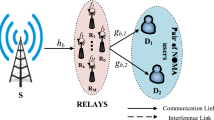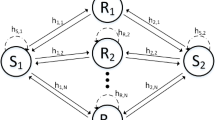Abstract
In this paper, optimum combining technique is applied to minimize the effect of Narrowband Interference (NBI) in Orthogonal Frequency Division Multiplexing based full duplex relay network. The NBI signal is assumed to be quasi-static over the duration of a transmitted signal. Multiple antennas are employed at Decode and Forward relay and destination nodes. The Probability Density Function of Signal to Interference Ratio at relay and destination nodes is derived using Hotelling’s T 2 distribution. Analytical expression for the end-to-end outage probability of the proposed network is derived using the hypergeometric functions. As the weight vector of the optimal combiner is determined using the statistics of the interference channels, the performance of the proposed network becomes better than the network with maximal ratio combining.







Similar content being viewed by others
References
Bingham, J. A. C. (2008). Multicarrier modulation for data transmission: An idea whose time has come. IEEE Communications Magazine, 28(5), 5–14.
Batra, A., & Zeidler, J. (2008). Narrowband interference mitigation in OFDM systems. In Proceedings on IEEE MILCOM (pp. 1–7). San Diego.
Batra, A., & Zeidler, J. (2009). Narrowband interference mitigation in BICM OFDM systems. In Proceedings on IEEE ICASSP (pp. 2605–2608). Taipei.
Nilsson, R., Sjoberg, F., & LeBlanc, J. (2003). A rank-reduced LMMSE canceller for narrowband interference suppression in OFDM-based systems. IEEE Transactions on Communications, 51(12), 2126–2140.
Sanguinetti, L., Morelli, M., & Poor, H.V. (2010). Robust EM-based detection of BICM-OFDM transmissions in the presence of narrowband interference. In European Wireless conference (pp. 696–700). Lucca.
Letaief, K. B., & Zhang, W. (2009). Cooperative communications for cognitive radio networks. Proceeding of the IEEE, 97(5), 878–893.
Zhang, Q., Jia, J., & Zhang, J. (2009). Cooperative relay to improve diversity in cognitive radio networks. IEEE Communications Magazine, 47(2), 111–117.
Laneman, J. N., Tse, D. N. C., & Wornell, G. W. (2004). Cooperative diversity in wireless networks: efficient protocols and outage behavior. IEEE Transactions on Information Theory, 50(12), 3062–3080.
Winters, J. H. (1984). Optimum combining in digital mobile radio with cochannel interference. IEEE Journal on Selected Areas in Communications, 2(4), 528–539.
Shah, A., & Hoimovich, A. M. (1998). Performance analysis of optimum combining in wireless communications with rayleigh fading and cochannel interference. IEEE Transactions on Vehicular Technology, 46(4), 473–479.
Shah, A., & Hoimovich, A. M. (2000). Performance analysis of maximal ratio combining and comparison with optimum combining for mobile radio communications with cochannel interference. IEEE Transactions on Vehicular Technology, 49(4), 1454–1463.
Aalo, V. A., & Zhang, J. (2000). Performance of antenna array systems with optimum combining in a Rayleigh fading environment. IEEE Communications Letters, 4(4), 125–127.
Yue, D., Wang, X., & Xu, F. (2006). Performance analysis for optimum combining of rayleigh fading signals with correlated Rayleigh interferers and noise. IEEE Communications Letters, 13(5), 269–272.
Suraweera, N., & Beaulieu, N. C. (2014). Optimum combining with joint relay and antenna selection for multiple-antenna relays in the presence of co-channel interference. IEEE Communications Letters, 18(8), 1459–1462.
Liu, F., Zhao, H., & Tong, Y. (2014). An eigen domain interference rejection combining algorithm for narrowband interference suppression. IEEE Communications Letters, 18(5), 813–816.
Yue, D. W., & Zhang, Q.T. (2006). Outage performance analysis of correlated mimo optimum combining systems with and without co-channel interference. In Proceedings on IEEE WTC (pp. 269–273). Chengdu.
Suraweera, N., & Beaulieu, N. C. (2015). Optimum combining for cooperative relaying in a poisson field of interferers. IEEE Transactions on Communications, 63(9), 3132–3142.
Suraweera, N., & Beaulieu, N. C. (2015). Optimum combining in dual-hop AF relaying for maximum spectral efficiency in the presence of co-channel interference. IEEE Transactions on Communications, 63(6), 2071–2080.
Yuksel, M., & Erkip, E. (2007). Multi-antenna cooperative wireless systems: A diversity-multiplexing tradeoff perspective. IEEE Transactions on Information Theory, 53(10), 3371–3392.
Riihonen, T., Werner, S., & Wichman, R. (2011). Transmit power optimization for multiantenna decode-and-forward relays with loopback self-interference from full-duplex operation. In IEEE Proceeding of ASILOMAR (pp. 1408–1412). Pacific Grove, CA.
Liu, G., Yu, F. R., Ji, H., et al. (2015). In-band full-duplex relaying: A survey, research issues and challenges. IEEE Communications Surveys & Tutorials, 17(2), 500–525.
Gray, R. M. (2006). Toeplitz and circulant matrices: A review. Breda: Now Publishers Inc.
Muirhead, R. J. (2005). Aspects of multivariate statistical theory. New York: Wiley.
James, A. T. (1964). Distributions of matrix variates and latent roots derived from normal samples. The Annals of Mathematical Statistics, 35, 475–501.
Author information
Authors and Affiliations
Corresponding author
Rights and permissions
About this article
Cite this article
Rajkumar, S., Thiruvengadam, S.J. Performance Analysis of Optimum Combining Technique in OFDM Based Full Duplex Multiantenna DF Relay Network with Narrowband Interference. Wireless Pers Commun 92, 547–563 (2017). https://doi.org/10.1007/s11277-016-3556-6
Published:
Issue Date:
DOI: https://doi.org/10.1007/s11277-016-3556-6




